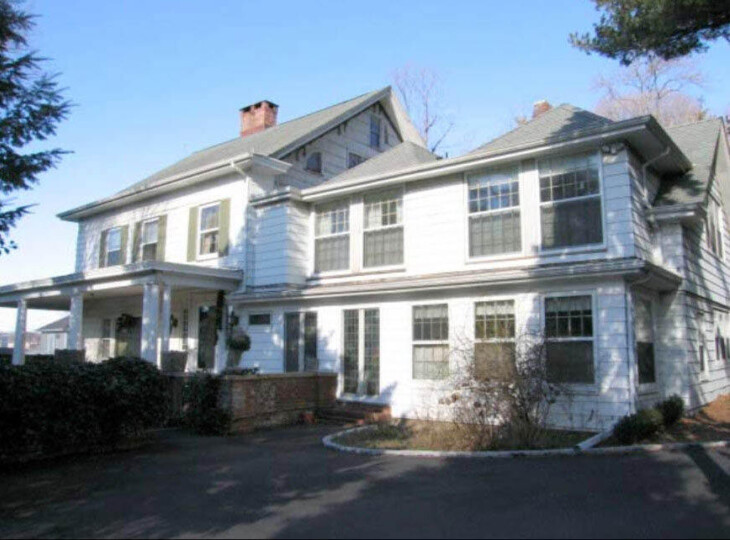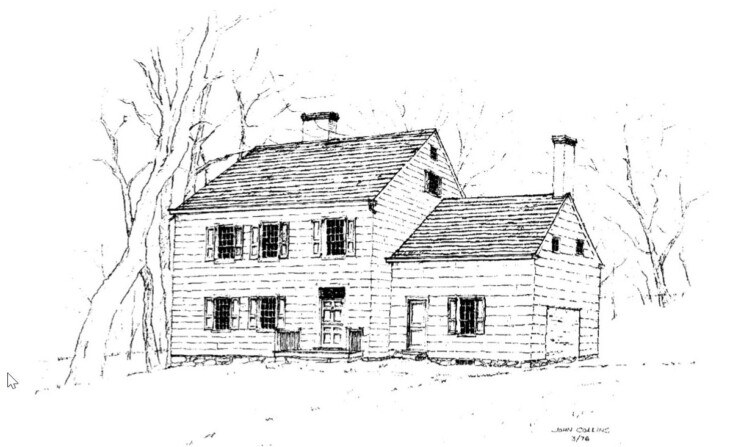Valentine-Robbins House
8 Church Street, Roslyn

The Valentine-Robbins house was built in two sections: the easterly portion of it is one of the earliest Valentine houses in this vicinity to which the family came late in the 17th century. The earliest recorded mention of a house on Richard Valentine's hundred acre tract on the east side of Hempstead Harbor, "near ye head thereof," was made in a will proved August 6, 1709 (Town Records, North and South Hempstead, Vol. Ill, Pg.317), when Richard Valentine left the entire tractto his oldest son, also named Richard. It is impossible to tell from that document whether the house transferred in 1709 is the oldest segment of the house standing there today. In 1728 the younger Richard Valentine added 6lA acres to his landholdings with a purchase from William Willis. That deed refers to "Richard Valentine's House," to which a road ran from the grist mill. Since the Valentines had more than one house, it is not known whether this is the one referred to there.
In 1753 Richard Valentine II gave his youngest son, Richard Valentine III, half of his lands and meadows, including "the farm and plantation where I now dwell with my East Dwelling House, Leanto, Upper Room and the Equal Half of the Cellars and the Equal Half of my Barn, Stables and out Houses, Orchard, Timber, trees, fences ..." It is very likely that that farm and plantation included the old wing of the Valentine-Robbins house.
In 1766 Richard Valentine Ill's will directed that the lands he held jointly with his father be divided. (New York Historical Society, Collections, Abstracts of Wills, Vol. VIII, Pg. 4). Certain parts of Richard Ill's holdings were to be sold to pay his debts. "Only I would not have my house, where my father now lives, sold," he stipulated, "and I would have my executors set apart so much of my movable estate as will be sufficient for my wife and children to keep house and carry on farming." He left his wife Phebe many of their household goods, including two beds, six sitting chairs, £2 worth of pewter, one "high Bilstede Chest" valued at 1.8s, and a riding chaise and horse worth £25.2s.6d. His son, Richard IV, was to have his house after Phebe died, and a double share of his estate. Richard Valentine Ill's sister had married Benjamin Robbins, who was named as an executor. Richard Valentine II died two years after his son, in 1768. His will (N-YHS Collections, Vol. VIII, Pg. 183) makes it clear that there were by then a number of houses owned by this branch of the Valentine family. One, which he left to the use of his sister Ann Pearsall, was called his "west dwelling house," and probably is not standing today. With it he left her the right to firewood to support one fire, the privilege of gathering apples, two barrels of cider yearly, a cow and a black horse — until she married.
Richard Valentine IV continued in possession of the Valentine lands until 1776, when in the revolutionary difficulties of the late summer he fled with his neighbor John Rogers to Connecticut for safety. On October 6, 1778, fearful that his property would be confiscated by the Crown because of his avowed patriot stand, he sold "the whole Real Estate [his] Grandfather Richard Valentine bequeathed [him]" to his uncle Jeremiah Robbins, who had lived in Oyster Bay. (Town Records, Vol. V, Pg. 81). According to Francis Skillman, who later owned the south part of the farm, Jeremiah had agreed that Richard was to have his property back, "should the times become safe for him to hold it." Skillman wrote in his reminiscences of Hempstead Harbor that Richard Valentine, unable to get his house and lands back at the end ofthe war, took to drink, and "laydrunkinthemill creek and the tide rose over him." This apparently did not occasion his death, as Skillman further reported that Valentine afterward built the structure that later became the Mansion House, and lived there for the rest of his life.
It may have been Jeremiah Robbins who added the great early Federal wing on the west side of the Valentine house around 1790. In 1795 a dispute aboutthe highway that later became School Street and Bryant Avenue (Town Records, Vol. VI, Pg. 360) mentioned a "line fence" separating Robbins' land from that of Andrew (Andries, Anderis) Onderdonk (TG 1970-1971). The same year, Jeremiah Robbins registered his claim to the ashes that were burnt in the Hempstead Harbor school house, which stood on a lot carved from his land where the Roslyn Hook & Ladder house stands today. (Town Records, Vol. VI, Pg. 464-65). And in 1805 another highway proceeding (Town Records, Vol. VI, Pg. 435) mentioned the boundary shared by Robbins and Richard Valentine Ill's grandson Richard Kirk, who owned the land that later became, in substantial part, the Cedarmere and Montrose estates of William Cullen Bryant's property. All of these landmarks: the Anderis Onderdonk land, the Hempstead Harbor school, and the Richard Kirk land, verify the fact that the Valentine Robbins farm comprised the lands that were later owned by John Tatterson (the Valentine-Robbins house), and Francis Skillman (the Blue Spruce Inn today).
On February 14, 1814, John and Daniel Robbins, possibly Jeremiah's sons or grandsons, made a deed of partition dividing the old farm into north and south halves. (Mentioned in Queens County Liber 70 of Deeds, Pg. 316). The Valentine-Robbins house went with the north half to Daniel Robbins. Whether John and Daniel inherited directly from Jeremiah Robbins, or purchased the property after his death, is not yet known.
Richard Tatterson was the next owner of the house, purchasing it on May 28,1823 (Queens County LiberS of Deeds, Pg. 109) from the estate of Daniel Robbins. The land by then contained abouta hundred acres, and it ran west to the high water mark of Hempstead Harbor. A fulling mill, its press house and its stream were reserved from the sale. John Tatterson, presumably Richard's son, acquired the farm on May 6,1835 (Queens County Liber JJ of Deeds, Pg. 482) and it was he who opened, in 1847, the small road that runs before the house (Witte's Lane) connecting Bryant Avenue with the Flushing-North Hempstead Turnpike. (Queens County Liber 81 of Deeds, Pg. 289).
Valentine Mott from New York City, bought the Valentine-Robbins house and farm from John Tatterson on February 16,1857 (Queens County Liber 158 of Deeds, Pg. 410) and his successor Stephen Mott sold it to Nathaniel M. Terry on April 23, 1863.
Later owners have included William J. Witte in 1906: Merrit Lund, who owned the house for about six years after 1907, making changes in the Colonial Revival style; and a family named Lowe who owned it in 1914 and sold the house in 1926 to Edmund Durkin. Following Mr. Durkin's death the house was acquired by a man named Gomper, who sold it to Frank B. Mendl, a retired State Senator, in 1951. Senator Mendl sold the house to the new owners in 1973.

Conjectured appearance 1800. Artist: John Collins, March 1976
0 Comments